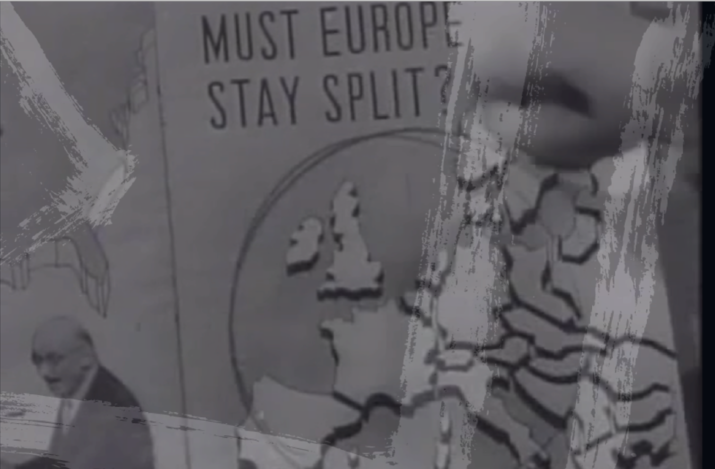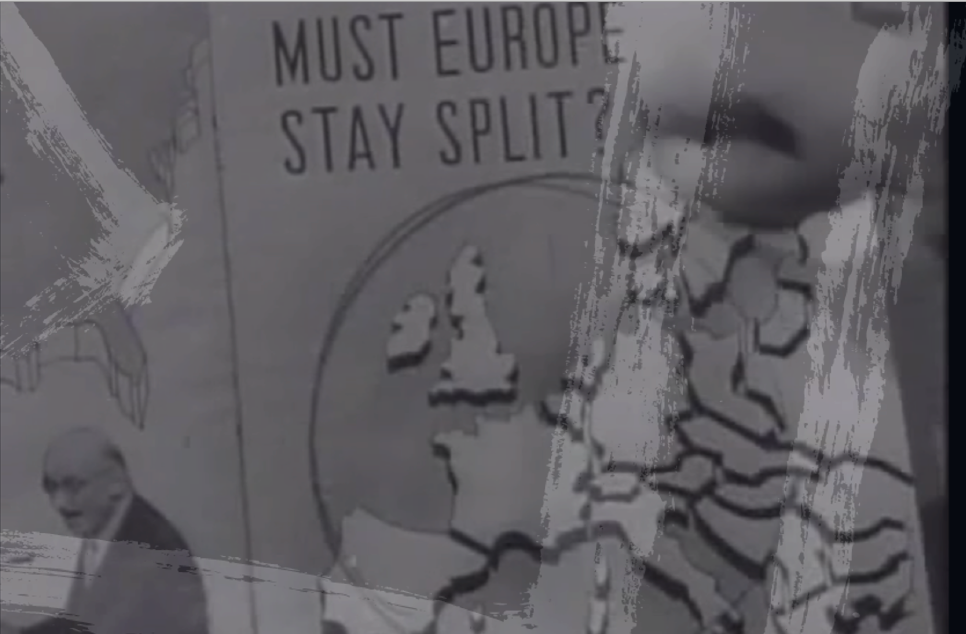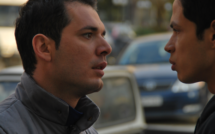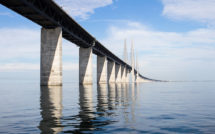

This is part of our special feature on European Culture and the Moving Image.
Already during World War II, leading European cultural figures oriented themselves toward a post-war future in which a federation of Europe would become a reality. Famous are essays like Jacques Maritain’s reflections on European federalism from the start of the war in 1940. Politicians followed this lead. Looking to the future, Winston Churchill, Léon Blum, Alcide de Gasperi, Paul-Henri Spaak, and other leaders of anti-fascist resistance turned to “Europe.” Precisely amidst the cataclysm of nationalist sentiments and fascist aggression that had overcome the European continent, Europe itself became the hopeful name of a new order.
This post-war revisioning of Europe was expressed in the form of text and spoken word, new festivals and exhibitions. Even the political founding figures of the European movement held lengthy speeches and wrote texts invoking the centrality of European culture, calling for European education.[1] But far less known is the role of the moving image in giving expression to that idea. This work begins as the German troops are withdrawing from occupied countries. To motivate spectators and provide the basis for a new post-fascist order, the resistance in France started to produce newsreels as early as 1944; and other visual materials contributing to the European movement began to appear with the liberation of the Netherlands, Belgium, and Luxembourg.[2] Common across the newsreels in Europe are images of last battles, destroyed buildings, displaced persons, hunger, confusion, but also clean up and rebuilding, trials, leaders, and youth—hopeful images asking, What next?[3] In 2007, the European Commission’s (EC) Audiovisual Services produced “From World War II to the European Coal and Steal Community,” selecting from the archive of newsreel footage to show well this transition of images from war-torn to hopeful Europe in cooperation.[4] Drawing on a multiplicity of sources, we recognize easily the emergence of a Europe in image. Scenes of liberation, consultative gatherings of military, congresses of European civilian leaders, and gatherings of a new political cadre are accompanied by images of peace treaties and other documents, along with maps and charts.
This archive of moving images condensed in the EC’s compilation film makes clear not just a historical growing momentum of the European movement, but how this space of Europe provided a new sense of international norms to the viewers. Indeed, the founding of the Council of Europe in 1948 and the European Coal and Steel Community (ECSC) in 1951 as European venues for national actors gave momentum to films doing what Gabriele Clemens called the work of “promoting Europe.”[5]
To grasp the extent of the project and how the national and the international interests intertwine, we can note how Maria Frabotta, discussing one governmental unit in Italy, the Documentation Center of the Italian Presidency, identified that this single center alone produced “between 1952 and 1962 over 4,000 copies of 200 short subjects [for export] abroad. These films were never longer than ten or fifteen minutes, and were dubbed into four languages—English, French, Spanish and Portuguese.”[6] The films were intended for export and they showed a new Italy with its leaders acting as agents on a European political stage, and its citizens oriented toward working in a common market.
The notion of promoting Europe through the use of moving images thus needs to be understood as multi-directional, oriented toward a European but also toward a national community. In these first decades, the project of the European movement was predicated on a coming together of national movements and regional interests to mutual benefit on a European stage. For instance, we can consider a series of items that were produced in Italy during this time. The short film “Verso la Costituente [Toward the Constitution]” (1946 Renato May) produced by the Ministry for the Constitution, an institution established to guide the process of transition from the Kingdom of Italy to the First Italian Republic (1945-1946), appears by topic to be a national consideration.[7] But immediately, we recognize in the credits that the film incorporates footage from British newsreels and French actualités. And we see this “upcycling” of newsreels into documentary and short films as a common language. The film begins with footage of post-war devastation, drawn precisely from the newsreels. It then moves on to a framing narrative, showing men moving through the rubble to gather with a professor in order to learn “what is a constitution.” The film then cuts away to a larger European history, the first constitutions in the so-called new world, the political transformations of the French Revolution, the Congress of Vienna, the 1848 movements, interwoven with the history of the Italian peninsula. Skipping over Italian fascism, the film reviews the 20s-45 through the developments in Germany and the rise of National Socialism. Before returning to the professor, it shows the destruction of the war and the triumph of De Gaulle speaking to the people of France. A short speech by the professor underscores the need for the Italian constitution. It is not a particularly complex film, but pairing “Verso” with the newsreel item “la conferenza della pace: De Gasperi a Parigi [The Peace Conference: De Gasperi in Paris]” (1946) shows something of the outcome.[8] With the constitutional assembly successfully behind him, the Prime Minister of the new Italian republic heads to the negotiations that would finally end the war with Italy. The newsreel does not show De Gasperi as a penitent or supplicant, but rather as a European leader in conversation with other leaders. Likewise in “Dall’Olanda: Congresso per gli Stati Uniti d’Europa. Fasi preparatorie alla costituzione del Consiglio d’Europa [In Holland: Congress for the United States of Europe: Preparatory Phase of the Constitution of the Council of Europe] (1948), a newsreel from two years later, we see similar iconography of European leaders gathering.[9] These all are imaginings of Italian and European community.
The production of European moving images was deemed as so important that in 1967, the Berlaymont Building, the new home of the European Commission in Brussels, opened with a modern broadcast studio in its basement. Additionally, Audiovisual Services began archiving images that now number over 500,000 moving images, photos and other still images—all available online. This archive documents various turns over the decades, collecting the work that they produce, but also collecting images from other sources in the EU and beyond. Audiovisual Services is only one of an elaborate set of resources.[10] Tucked away in various archivers we find gems about surrealist Italian bureaucrats, radioactive French scientists, Benelux rail journeys, and an episode of the popular French revue show: Top club sans frontières broadcast on the eve of the first European elections.[11] These require some consideration and background to understand their relation to Europe. The colorfully animated film “Un atome qui vous veut de bien [An Atom that wishes you well]” (1959) appears to promote a particular approach to nuclear power developing in France. The sequence in which the scientist/narrator assures us that we do not need to worry about nuclear waste—because the oceans are very deep—is accompanied by images of a futuristic container drifting to the bottom of the ocean in a way that elicits shock and alarm in a contemporary audience. Yet the film, which seems redolent of a particular national approach to nuclear power, aligns with the creation of Euratom in 1957 and the formation of a common West European nuclear initiative with its main research facilities in Ispra, Italy.
These moving images offer surprising insights into the complex history of the European movement. They help us understand the developments of post-war Europe as multi-institutional and multi-trajectoried, a complex connectivity of the national and transnational. And yet, there exists little work on this archive to date. The historian Gabriele Clemens (emeritus) assembled a research group at the University of Hamburg 2011-2016 that produced an important German language discussion of this work from 1948-1962. From that project, they placed an initial collection, the Advertising Europe Film Archive, at the European University Institute in Florence. The opening of the Marshall Funds archives around the same time also led to related studies by Maria Fritsche and Jan Uelzmann.[12] Eugen Pfister’s German language comparative project compared the image of Europe in German, French, British, and Austrian postwar newsreels.[13] He, along with Anne Bruch, set the images in a longer history of European iconography in a co-authored paper.[14]With Frabotta’s article on post-war Italian newsreels, we have a list of the currently major published studies.[15] There is much room for research.
These narratives counter a certain telos that has developed out of EU scholarship that traces a teleological development from the 1948 Congress of Europe in the Hague, through the European Coal and Steel Community (1951), all the way to the Maastricht Treaty (1992) to the present configuration. A film like “Saarland Glück auf! [Saarland in Good Luck]” (1951) holds great interest not just because the renowned French Cameraman and Director Henri Alekan was drawn in to make the project, but because it is a contribution to European history that counters the easy vision of the ECSC.[16] It is a stunning short film, forgotten, in part, because it was made during the tense phase in which France occupied and almost annexed the Saarland. It was recently recovered and restored. The film celebrates the Saar Protectorate as an autonomous region, beginning with the common trope of war-torn landscapes and devastation, territorial maps, and scenes of rebuilding efforts. Its visuals become striking as it turns to the revitalization of industry. The Saarland as central to the regions steel production appears here as a site of post-war industrial modernization. Alekan advances a vision of industrial beauty showing repeatedly the spray of sparks from the pouring of molten steel and a ballet of men tossing the glowing bars by hand. A similar dance of glassblowers comes later in the film. This visual celebration of heavy industry also marks the ECSC oriented films. “Saarland Glück auf!” switches to scenes of countryside, and family life. A young girl does her homework at the table as her father returns from work. Her study of regional history sets off a visual exploration of local cultural specificity and heritage. It argues in its conclusion, amidst a rising swell of local patriotic anthems and in the voice of a young girl extolling the virtues of her homeland, that the Saar’s autonomy between the great nations secures Europe’s peace.
There is much that could be said further; filmmaker and scholar Thomas Tode did offer a longer discussion of this film in German.[17] But what I want to underscore is that placing this short film in its larger historical context points to a multi-directional dynamic in the European project. The Saarland, as French protectorate, de facto became part of the ECSC. But here, the film’s assertion of local identity addresses the tensions of the moment and moves the region toward independence from France and Germany. By 1954, to resolve the increasingly fraught situation, France and Germany moved the region toward a referendum. The options were a Europeanized state under the control of the West European Union (something like DC for Europe) or integration into the West German state. The referendum went for unification but the film offers an imagination of European and regional community that stands as alternative to the preferred narrative of the German nationalists and the ECSC. The European project is not one of an easy telos.
In The Europeanization of Cinema: Interzones and Imaginative Communities I introduced a distinction between the imagined community of the nation-state and the possibility of other imaginative communities.[18] Europeanization is not simply the easy and immediate sublation of the nation-state into a broader and more advanced federal form—even if that goal is aspirational in many of the films. The nation-state in a federated Europe remains a centralizing force in community building, resourced in ways that make other imaginings of community, like Europe or the Saar, more tenuous, precarious, transient. I argued in my earlier work that imaginative communities develop not as metacommunities but as subcultures, micropolitical associations, ethnic migrant identities, midlevel economic partnering, sexual communities, and other “lower order” distinctive societies. To be precise about the discussion I have developed here, I want to underscore that these films offer a visual language to a European imaginative community, yet also circulated in national imagined communities.
The imagined and imaginative community can align but also diverge; as illustration we can consider further Italian contributions. Shortly after the development of the ECSC, the orientation toward Europe in Italy starts to take a new turn. “Nasce l’Europa: Mondo libero” (1954) presents integration into Europe as political respectability and economic modernization.[19] Relying on a recycling of newsreel footage into a compilation film, the voiceover narrator describes Italian integration into the ECSC as a success and it shows a new Italian migration as a contribution to Europe. Italy is hailed as providing educated workers, skilled laborers to help rebuild the devastated regions of the north. A series of films develops with similar arguments but more explicitly oriented toward the preparation of labor migrants to the north. With “La Comunità Europea” (1955), “Mercato Comune Europeo” (1958), and “Passaporto Europeo” (1958) the focus on the ECSC intensifies, presenting it as advantageous for Italian workers.[20]
Suddenly, with the start of the 60s, we can find a dramatic shift. “Minatori italiani in Belgio [The Italian Minority in Belgium]” (1961 Luigi Scattini) portrays the working and living conditions—often full of privation—for Italian migrant workers in Belgium who were recruited on the basis of the Treaty of Rome.[21] And with “gli Isolati [The Isolated]” (1964 Toni de Gregorio) we have a damning portrait of the conditions in Belgium.[22] Because of overproduction, i.e. the success of the liberalization of the open market, the High Authority of the ECSC ordered Belgium to roll back its coal production. The first hit were the Italian laborers; never integrated into the society, treated rather as second class, housed in barracks, and isolated. The film portrays them in the opposite of the hygienic conditions promised; the workers are shown drinking, smoking, gambling and even going to bordellos. A voice over narrator describes the conditions at the start of the film but two thirds of the film is without dialogue accompanied by an electronic score that seems very dated at this point, but nevertheless conveys a sense of failure of a modern promise.
This film can mark for us the emergence of Euroscepticism and a distinct national criticism of the project of Europe. Certainly, the documentarist Gregorio had a socially critical orientation in his work. Important also is that this film is one made for the medium of television. Saturation of television per household in the 1960s allows the luxury item to take off as a means of mass communication in Italy.[23] And it does so in a nationally organized market. Europe, the orientation toward Europe of the newsreel, now gives way to a differently sourced and nationally oriented medium. Europe appears here as a negative space for the labor migrant. Labor migration as such becomes a point of contentious debate in Italy and settles in to become a central theme too of the European imaginative communities. That moment of the shift of the moving image from cinema to television invites us to consider further how various emergent technologies address European imaginative communities.
The archive of images I am introducing here is an archive not centrally housed but spread throughout various institutions and databases. Nevertheless, it is important to consider this long history of Europe’s moving images and this survey reveals various distinctive qualities about the European visual language, its development in the post-war era, and its ability to circulate as part of imagined and imaginative communities. This archive invites us to develop further our theoretical methodological investigations of the images that move Europe.
Randall Halle is the Klaus W. Jonas Professor of German Film and Cultural Studies at the University of Pittsburgh. He directs the Film and Media Studies Program, as well as the Critical European Culture Studies Program. His books include The Europeanization of Cinema and German Film after Germany. This article is part of his current research project.
References
Althaus, Scott L., Kaye Usry, Stanley Richards, Bridgette Van Thuyle, Isabelle Aron, Lu Huang, Kalev Leetaru, et al. “Global News Broadcasting in the Pre-Television Era: A Cross-National Comparative Analysis of World War II Newsreel Coverage.” Journal of Broadcasting & Electronic Media 62, no. 1 (2018): 147–67. https://doi.org/10.1080/08838151.2017.1375500.
Anderson, Benedict R. O’G. Imagined Communities: Reflections on the Origin and Spread of Nationalism. New York: Verso, 2006.
Chambers, Ciara, Mats Jönsson, and Roel Vande Winkel. Researching Newsreels: Local, National and Transnational Case Studies. Global Cinema. Cham: Springer International Publishing AG, 2018. https://doi.org/10.1007/978-3-319-91920-1.
Clemens, Gabriele, ed. Werben Für Europa: Die Mediale Konstruktion Europäischer Identität Durch Europafilme. Paderborn: Ferdinand Schöningh, 2016.
Drechsel, Benjamin, Friedrich Jaeger, Helmut König, Anne-Katrin Lang, Claus Leggewie, Julia Schmidt, Angela Siepmann, and Marcel Siepmann. Bilder von Europa: Innen- und Außenansichten von der Antike bis zur Gegenwart. 1st ed. Bielefeld: transcript Verlag, 2010.
Evolvi, Giulia. “The Myth of Catholic Italy in Post-Fascist Newsreels.” Media History 24, no. 1 (2018): 71–85. https://doi.org/10.1080/13688804.2016.1207510.
Frabotta, Maria Adelaide. “Official Italian Newsreels of the 1950s: Europeanism and International Politics.” Historical Journal of Film, Radio and Television 15, no. 3 (August 1995): 361–65. https://doi.org/10.1080/01439689500260241.
Fritsche, Maria. The American Marshall Plan Film Campaign and the Europeans: A Captivated Audience?London, UK ; New York, NY: Bloomsbury Academic, 2018.
Grasso, Aldo, Luca Barra, and Cecilia Penati. Storia critica della televisione italiana. Milano: Il Saggiatore, 2019.
Halle, Randall N. The Europeanization of Cinema: Interzones and Imaginative Communities. Urbana: University of Illinois Press, 2014.
Hallstein, Walter. “The Unity of European Culture and the Policy of Uniting Europe. Address by Professor Dr. Walter Hallstein, President of the Commission of the European Economic Community.” EU Speech presented at the The Second Congress of the European Foundation for Cultural Purposes., Milan, December 13, 1958. http://aei.pitt.edu/14887/.
Pfister, Eugen. Europa im Bild: Imaginationen Europas in Wochenschauen in Deutschland, Frankreich, Großbritannien und Österreich 1948-1959. 1st ed. Göttingen: V&R Unipress, 2014.
Pfister, Eugen, and Anne Bruch. “What Europeans Saw of Europe: Medial Construction of European Identity in Information Films and Newsreels in the 1950s.” Journal of Contemporary European Research 10, no. 1 (2014): 26–43.
Sassatelli, Monica. “The Arts, the State, and the EU: Cultural Policy in the Making of Europe.” Social Analysis51, no. 1 (March 1, 2007): 28–41. https://doi.org/10.3167/sa.2007.510103.
Schuman, Robert. Pour l’Europe. 2e éd. Écrits Politiques. Paris: Éditions Nagel, 1964.
Tode, Thomas. “‘Recontres Sur Le Rhin’: Der Französische Europafilm Und Die Fixierung Auf Das Französisch-Deutsche Verhältnis.” In Werben Für Europa: Die Mediale Konstruktion Europäischer Identität Durch Europafilme, edited by Gabriele Clemens, 229–91. Paderborn: Ferdinand Schöningh, 2016.
Uelzmann, Prof Jan. Staging West German Democracy: Governmental PR Films and the Democratic Imaginary, 1953-1963. Illustrated Edition. New York London Oxford New Delhi Sydney: Bloomsbury Academic, 2020.
Uhl, Heidemarie, Vrääth Öhner, Andreas Pribersky, and Wolfgang Schmale. Europabilder. 1st ed. Innsbruck Wien München: Studien Verlag, 2005.
[1] Hallstein, “The Unity of European Culture and the Policy of Uniting Europe”; Schuman, Pour l’Europe.
[2] Pfister, Europa im Bild. See also the collection of France Libre Actualités at https://institut.ina.fr/en/collections/newsreels-and-film
[3] Chambers, Jönsson, and Vande Winkel, Researching Newsreels; Evolvi, “The Myth of Catholic Italy in Post-Fascist Newsreels”; Althaus et al., “Global News Broadcasting in the Pre-Television Era.”
[4] https://europa.eu/!3HRFGR note that the online resources of the Audiovisual Services are available for download and can be used further in reporting, teaching, or appropriation into new films.
[5] Clemens, Werben Für Europa.
[6] Frabotta, “Official Italian Newsreels of the 1950s,” 361.
[7] https://www.youtube.com/watch?v=LX7-8CqTu14
[8] https://www.youtube.com/watch?v=pBaPZT_QX9E
[9] https://youtu.be/Rkme54v51K8
[10] Further archives include but are not limited to
Archive of European Integration http://aei.pitt.edu/
Archivo Audiovisivo del Movimentao Operaio e Democratico http://patrimonio.aamod.it/aamod-web/
Archivo Luce https://www.archivioluce.com/
Audiovisual Service of the European Commission https://audiovisual.ec.europa.eu/en/search
Bundesarchivfilm https://www.filmothek.bundesarchiv.de/
Centre Virtuel de la Connaissance sur l’Europe (CVCE) https://www.cvce.eu/
Cineteca Bologna http://cinestore.cinetecadibologna.it/
Eye Filmmuseum https://www.eyefilm.nl/
Historical Archives of the European Union https://archives.eui.eu/#Collections
Institut national de l’audiovisuel https://www.ina.fr/
International war museum https://www.iwm.org.uk/collections
Partire è un po morire (1951)
https:/www.youtube.com/watch?v=gQyKBBFAurw
E comme Europe (1952)
https://www.ina.fr/video/VDD09016194
Un atome qui vous veut de bien [An Atom that wishes you well] (1959)
https://www.youtube.com/watch?v=rNgUPkc8lGM
Top club sans frontières (1979)
https://madelen.ina.fr/programme/emission-du-10-juin-1979
[12] Fritsche, The American Marshall Plan Film Campaign and the Europeans; Uelzmann, Staging West German Democracy.
[13] Pfister, Europa im Bild.
[14] Pfister and Bruch, “What Europeans Saw of Europe: Medial Construction of European Identity in Information Films and Newsreels in the 1950s.”
[15] Frabotta, “Official Italian Newsreels of the 1950s.” We can add a group of German historians who have looked at still images: Uhl et al., Europabilder; Drechsel et al., Bilder von Europa.
[16] https://www.youtube.com/watch?v=n72f6EqkAUQ
[17] Tode, “‘Recontres Sur Le Rhin’: Der Französische Europafilm Und Die Fixierung Auf Das Französisch-Deutsche Verhältnis.”
[18] Halle, The Europeanization of Cinema: Interzones and Imaginative Communities; Anderson, Imagined Communities: Reflections on the Origin and Spread of Nationalism.
[19] https://www.youtube.com/watch?v=U9lqPBaAq8U
http://cinestore.cinetecadibologna.it/video/dettaglio/19175%22
https://archives.eui.eu/en/fonds/516617?item=AE-10
https://patrimonio.archivioluce.com/luce-web/detail/IL5000092007/2/passaporto-europeo.html
[21] https://archives.eui.eu/en/fonds/516622?item=AE-15
[22] http://cinestore.cinetecadibologna.it/video/dettaglio/20395
[23] Grasso, Barra, and Penati, Storia critica della televisione italiana.




